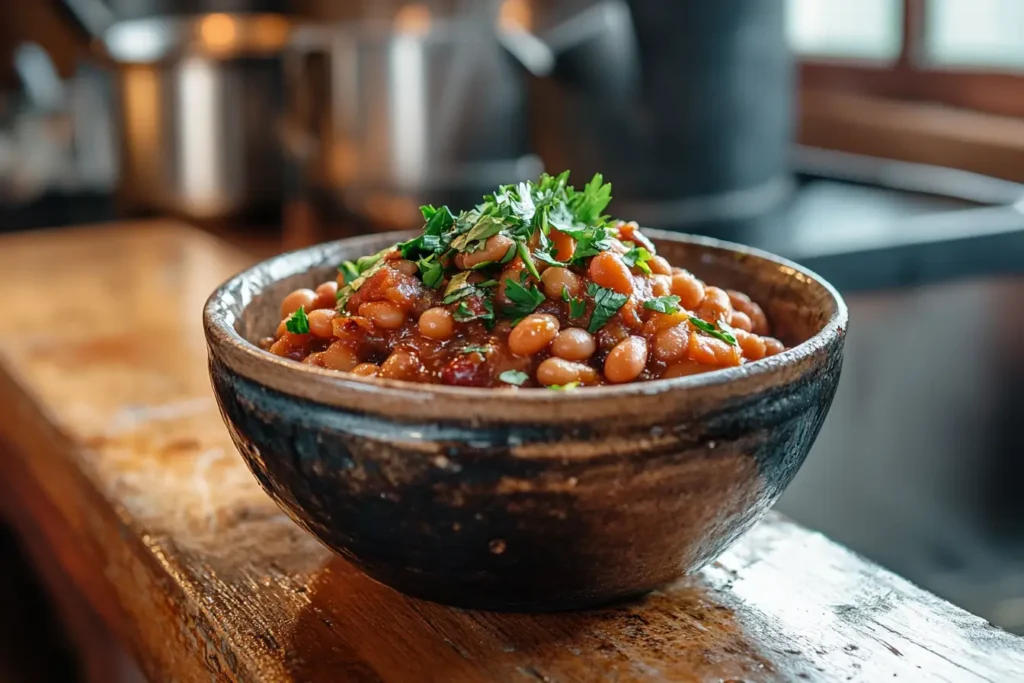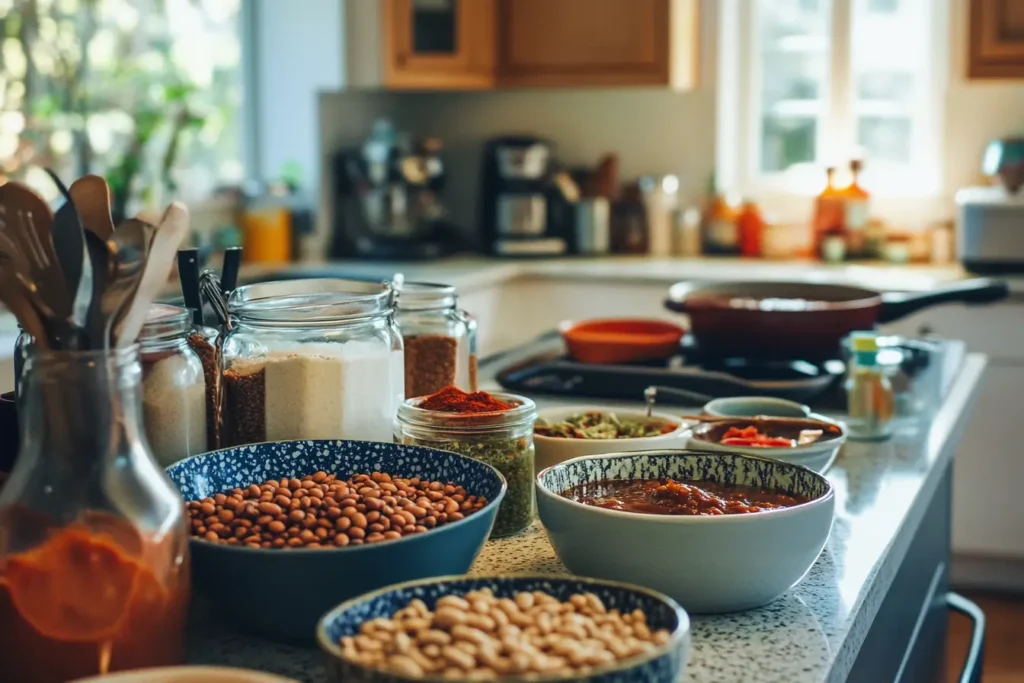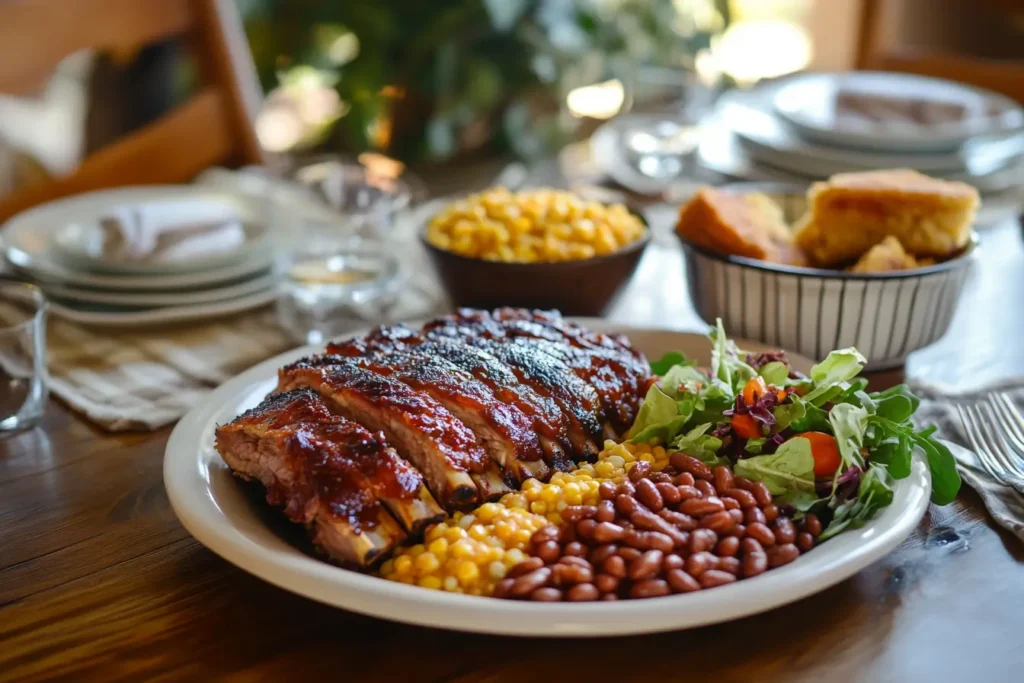
What Are the Ingredients for Baked Beans?
When you think of baked beans, you probably picture a comforting, saucy dish that’s hearty, sweet, and savory all at once. But have you ever stopped to wonder about the ingredients for baked beans that create that irresistible flavor? Whether you’re planning to whip up your own batch or you’re just curious about this culinary staple, this article will spill the beans (pun intended!) on everything you need to know. So, grab your apron and let’s dive into the world of baked beans! 😋
Introduction to Baked Beans
Baked beans aren’t just a side dish – they’re a culinary icon. In fact, they’ve been around for centuries, gracing dinner tables at barbecues, breakfast plates, and even camping trips. But what exactly makes baked beans so special? Ultimately, it’s the perfect balance of sweet, tangy, and savory, achieved through a careful mix of ingredients that, like old friends, complement each other beautifully.
A Brief History of Baked Beans
Let’s take a stroll down memory lane. Did you know the ingredients for baked beans have roots in Native American cuisine? Early versions of the dish included beans slow-cooked with fat and sweeteners like maple syrup. When European settlers arrived, they added their twist, incorporating ingredients like molasses and pork. Over time, baked beans became a beloved dish in both North America and beyond, evolving into the versatile comfort food we enjoy today.
Why Are Baked Beans So Popular?
Why are baked beans so universally loved? For one, they’re incredibly versatile. You can serve them with breakfast, alongside a juicy steak, or even enjoy them as a standalone meal. Plus, they’re packed with protein and fiber, making them as nutritious as they are delicious. And let’s not forget the sauce – that rich, flavorful coating that turns humble beans into a masterpiece. It’s like the cherry on top of a sundae but for savory food lovers. 🍒
Core Ingredients for Baked Beans in Traditional Recipes

So, what exactly goes into baked beans? While recipes vary, there are a few staple ingredients that form the backbone of this classic dish. Let’s break them down.
Beans: The Heart of the Recipe
The star of the show, without a doubt, is the beans. But not just any beans – navy beans are the most popular choice when it comes to the ingredients for baked beans. They’re small, creamy, and absorb flavors like a sponge. Other varieties like pinto or cannellini beans work too, but there’s something about navy beans that just hits differently.
“Beans are like blank canvases – they take on the flavors of whatever you cook them with.” – That’s why choosing the right type is crucial!
Tomato Sauce: The Essential Base
Next up, the sauce. A good baked beans recipe almost always includes tomato sauce or paste as the base. It adds a rich, tangy flavor that ties everything together. Some recipes also use ketchup for an extra hit of sweetness and tang. Think of tomato sauce as the glue that holds all the other flavors in harmony.
Sweeteners: Sugar, Molasses, and More
Here’s where the magic happens. Sweeteners like brown sugar or molasses give baked beans their signature sweetness. Molasses, in particular, adds a deep, almost caramel-like flavor that’s hard to replicate with anything else. Some recipes even sneak in maple syrup for a hint of natural sweetness.
👉 Pro Tip: Be careful not to go overboard with the sweeteners – you want a balanced flavor, not dessert beans!
Flavor Enhancers: Vinegar and Spices
What’s a dish without some seasoning? Vinegar adds a tangy kick that cuts through the sweetness, while spices like mustard powder, garlic, and paprika elevate the flavor profile. And let’s not forget salt and pepper – they might seem basic, but they’re essential for bringing out the best in every ingredient.
“Cooking without seasoning is like painting without color – sure, you can do it, but it’ll be pretty bland.”
Variations of Baked Beans Recipes
Now that we’ve covered the basics, let’s talk about how you can mix things up. One of the best things about baked beans is how adaptable they are. Whether you’re vegan, a meat lover, or just looking to try something new, there’s a recipe variation out there for you.
Regional Variations in Ingredients
Did you know baked beans look and taste different depending on where you are? For instance, in the UK, they’re usually less sweet and served in a thinner tomato sauce. Meanwhile, Southern-style baked beans in the US often include bacon and extra molasses, making them richer and heartier. Additionally, if you head to Boston, you’ll find “Boston baked beans” made with a generous helping of molasses. Truly, it’s like every region has its own love letter to baked beans. ❤️
Vegetarian and Vegan Alternatives
If you’re skipping meat, don’t worry – baked beans have your back. Many recipes swap out bacon or pork for plant-based alternatives like smoked tofu or tempeh. You can also amp up the flavor with liquid smoke or smoked paprika to mimic that rich, smoky taste.
Adding Meat: Bacon, Sausage, and More
For the meat lovers out there, adding bacon or sausage is a game-changer. In addition, the fat from the meat infuses the beans with a smoky, savory flavor that’s downright irresistible. Furthermore, some recipes even go all out with chunks of ham or ground beef. Ultimately, it’s like giving your beans a cozy meat blanket that wraps them in deliciousness.
Common Problems When Making Baked Beans
Let’s be real for a second – as delicious as baked beans are, they’re not always the easiest dish to get right. For example, have you ever spent hours in the kitchen, only to end up with beans that are too hard, a sauce that’s watery, or flavors that are just off? Don’t worry – it happens to the best of us. However, the good news is that most of these issues are super fixable. Therefore, let’s break them down step by step and turn those bean fails into bean wins. 🌟
Beans Not Softening Properly
Ah, the dreaded hard beans. You’ve soaked them overnight, simmered them for hours, and still, they’re refusing to soften. What’s going on?
The Problem: Old beans. Yes, beans can age, and the older they are, the harder they’ll be to cook. Another culprit could be hard water – the minerals can interfere with the cooking process.
The Fix:
- Check Your Beans – Always buy fresh beans. If they’ve been sitting in your pantry for years, it’s time to say goodbye.
- Use Baking Soda – Adding a pinch of baking soda to your cooking water can help soften the beans by breaking down their tough outer skin. Just don’t go overboard, or you’ll end up altering the flavor.
- Cook Low and Slow – Patience is key. Simmering beans gently for several hours will give them time to soften properly.
“Cooking beans is like building trust – it takes time, but the results are worth it.”
Overly Sweet or Tangy Flavor
Nobody likes beans that taste like candy (or straight-up vinegar). Achieving the perfect balance of sweet and tangy is a bit of an art.
The Problem: Too much of one ingredient – maybe you got a little heavy-handed with the molasses, or you added a splash too much vinegar.
The Fix:
- Balance the Flavors – If your beans are too sweet, add a splash of vinegar or lemon juice to cut through the sweetness. If they’re too tangy, stir in a bit more sugar or molasses to round things out.
- Taste as You Go – This is a golden rule for cooking. Don’t just dump everything in at once – add ingredients gradually and keep tasting until you hit the sweet spot.
Sauce Too Watery or Too Thick
Getting the sauce just right is like finding the Goldilocks zone – not too runny, not too gloopy, but just right.
The Problem: A watery sauce can make your beans feel underwhelming, while a too-thick sauce can be overly cloying.
The Fix:
- For Watery Sauce – Simmer your beans uncovered for a bit to let the liquid reduce. If you’re short on time, a slurry of cornstarch and water can thicken things up quickly.
- For Thick Sauce – Add a splash of water, broth, or tomato sauce to loosen things up. Stir gently to incorporate the liquid evenly.
👉 Pro Tip: The sauce will thicken slightly as it cools, so don’t panic if it seems a little runny right after cooking.
Tips and Tricks for Perfect Baked Beans
Now that we’ve tackled the common problems, let’s talk about how to elevate your baked beans from good to absolutely amazing. Whether you’re a seasoned pro or a bean newbie, these tips will take your dish to the next level.
Choosing the Right Type of Beans
Not all beans are created equal. Navy beans are the classic choice for baked beans, but don’t be afraid to experiment with others like cannellini, pinto, or even black beans.
“Think of beans like shoes – different styles work for different occasions.” For a creamy texture, go for navy beans. If you want something heartier, pinto beans are your best bet.
Adjusting the Sweet and Savory Balance
One of the secrets to unforgettable baked beans is nailing the balance between sweet and savory flavors. It’s all about personal preference, so don’t be afraid to tweak the recipe.
- Love it sweet? Add more brown sugar or molasses.
- Prefer it savory? Go heavier on the mustard, garlic, and vinegar.
“Your baked beans should be like a good conversation – balanced, interesting, and satisfying.”
Slow Cooking vs. Quick Preparation Methods
Let’s talk about cooking methods. While slow cooking is the traditional way to make baked beans, sometimes life gets busy, and you need a faster option.
- Slow Cooker – This is the best method for deep, developed flavors. Just set it and forget it. Bonus: your kitchen will smell amazing all day.
- Pressure Cooker/Instant Pot – Perfect for when you’re short on time. You’ll get tender beans in a fraction of the time, though the flavors might not be as rich.
- Oven Baking – A happy medium. Baking your beans in the oven gives you a thick, caramelized sauce and evenly cooked beans.
👉 Pro Tip: If you’re using a pressure cooker, reduce the amount of liquid in your recipe to prevent watery beans.
Nutritional Insights of Baked Beans
Now, let’s dig into why baked beans aren’t just tasty but also good for you. It’s like eating a dish that loves you back. ❤️
Health Benefits of Key Ingredients
- Beans – They’re loaded with protein, fiber, and essential vitamins like folate. Plus, they’re low in fat, making them a heart-healthy choice.
- Tomato Sauce – A great source of antioxidants like lycopene, which is good for your skin and heart.
- Molasses – Packed with iron, calcium, and magnesium, it’s a sweetener with benefits.
Potential Dietary Concerns
While baked beans are generally healthy, there are a couple of things to watch out for:
- Sugar Content – Some recipes (especially store-bought ones) can be high in sugar. Opt for homemade versions to control the sweetness.
- Sodium – Canned beans and sauces can be loaded with salt. Rinse canned beans before cooking or choose low-sodium options.
“Think of baked beans as a treat – enjoy them in moderation, and they’ll do your body good.”
Popular Serving Suggestions for Baked Beans

Baked beans are like a culinary chameleon – they can adapt to almost any meal. Whether you’re looking for a hearty breakfast or a mouthwatering side dish, these serving ideas will inspire you to think beyond the basics.
Pairing with Breakfast, Lunch, or Dinner
Who says baked beans are just for one meal? To start your day strong, try pairing them with eggs, toast, and a sprinkle of fresh herbs. Additionally, for lunch, they’re perfect alongside a fresh green salad or tucked into a wrap with roasted vegetables. Moreover, for dinner, you can serve baked beans as a side to barbecue ribs, grilled chicken, or even baked salmon. In fact, they’re like the Swiss Army knife of side dishes – always versatile and always satisfying.
Using Baked Beans as a Side Dish
Baked beans are the ultimate sidekick, always ready to make any dish shine. For example, they’re a natural fit for summer barbecues, picnic spreads, and potlucks. Additionally, if you’re feeling fancy, try spooning them over crispy cornbread or pairing them with loaded baked potatoes. Moreover, for inspiration, check out Southern-style cornbread recipes for a delicious match.
Homemade vs. Store-Bought Baked Beans
When it comes to baked beans, you have two main options: whip them up from scratch or grab a can off the shelf. Let’s weigh the pros and cons of each.
Comparing Ingredients for Baked Beans and Their Nutritional Value
Homemade baked beans give you complete control over the ingredients for baked beans. You can adjust the sweetness, skip unnecessary additives, and even experiment with flavors. On the other hand, store-bought beans are convenient but often contain more sugar and sodium. Curious about healthier choices? Learn how to make meals both tasty and nutritious with tips like rotisserie chicken storage and usage ideas.
The Cost Factor: Which Is Cheaper?
Making baked beans from scratch is often cheaper, especially if you buy beans in bulk. However, canned beans are undeniably convenient and great for last-minute meals. If you’re on the fence, consider experimenting with both options to see what works best for your lifestyle.
Fun Facts and Trivia About Baked Beans
Want to impress your friends with some baked bean trivia? Here are some fun tidbits that might surprise you:
- Historical Roots: Native Americans were the first to cook beans with sweeteners like maple syrup, creating an early version of baked beans.
- Boston’s Nickname: Boston is often called “Beantown” due to its association with molasses-based baked beans, a favorite in colonial times.
- Worldwide Appeal: In the UK, baked beans are a staple breakfast item, often served on toast. In France, they’re used in dishes like cassoulet, a rich bean stew.
- Record Holder: Did you know the largest serving of baked beans ever made weighed over 1,000 pounds? Now that’s a party! 🎉
FAQs About Ingredients for Baked Beans
Let’s tackle some common questions people have about baked beans. We’ve also included helpful internal links to make this section even more resourceful.
Are baked beans healthy to eat?
Yes! Baked beans are a great source of protein, fiber, and essential nutrients. Just be mindful of the sugar and sodium levels, especially in store-bought versions. For more insights, check out this guide on the health benefits of baked beans.
What are some creative ways to serve baked beans?
Get creative by pairing baked beans with barbecued meats, using them in casseroles, or even adding them to breakfast spreads. Need more ideas? Explore unique breakfast casserole ideas to elevate your meal planning.
How can I make baked beans more flavorful?
Boost the flavor by adding ingredients like smoked paprika, bacon, or fresh herbs. If you’re working with canned beans, enhance them by simmering with molasses or brown sugar. For tips on perfecting sauces, see this guide on fixing flavors in recipes.
Are there vegetarian or vegan options for baked beans?
Absolutely! Skip the meat and add plant-based ingredients like smoked tofu or tempeh. Love exploring plant-based dishes? Discover more about meatless meal ideas to inspire your next recipe.
Conclusion: The Versatility of Baked Beans
Baked beans aren’t just a dish – they’re a culinary journey. From their rich history to their endless serving possibilities, they bring comfort and creativity to the table. Whether you’re making them from scratch or sprucing up a canned version, baked beans are a simple yet satisfying addition to any meal.
Ready to dive into your next batch? Check out these baked bean recipes for inspiration and make your kitchen the coziest spot in the house. Happy cooking! 🍽️
